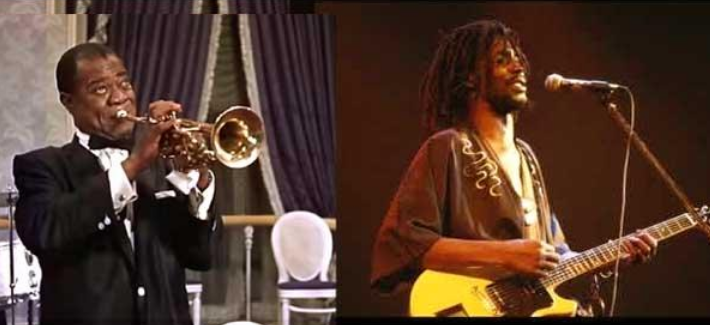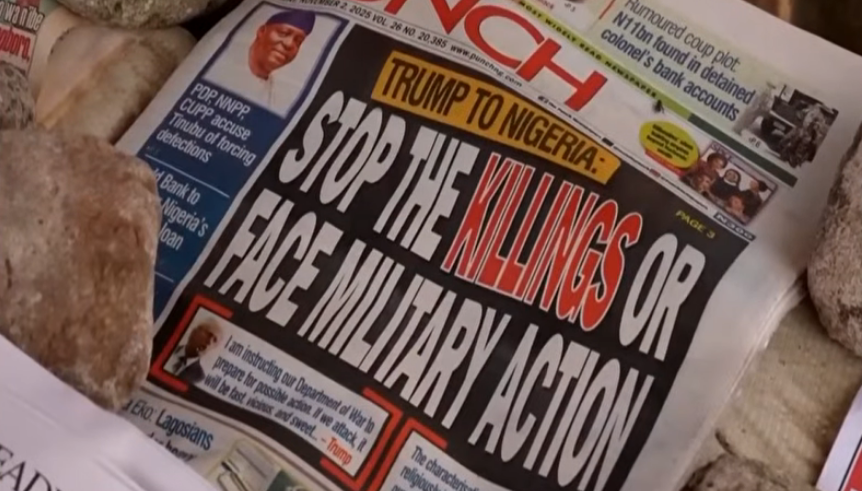Photos: Ras Kefim\YouTube Screenshots\Wikimedia Commons
The following article, part#1 of a series, by New York-based author and businessman Ras Kefim examines the similarities between Jazz giant Louis Armstrong and Reggae great Peter Tosh. Ras Kefim is the author of the book Deception In the Name Of the Lord. Read more about Deception In the Name Of the Lord in this Black Star News article.

Louis Armstrong and Peter Tosh are two musical names you likely may not associate together. But, believe it or not, there are many parallels or similarities between the lives of these two musical giants, undisputed masters of the arts. Their genius execution of musical compositions and accomplishments could not betray the fact that their lives were lived fighting for personal and human rights.
It is for this reason they were able to leave an indelible chapter of achievements relating to their contribution to social consciousness, promoting change, challenging establish norms and social codes they thought were oppressive, especially to people like themselves.

Louis Daniel Armstrong was born on August 4, 1901, in a section of New Orleans, Louisiana, called, “the Battlefield” in the United States of America. He is popularly known by his nickname, “Satchmo,” a Yiddish word meaning, “big cheeks.”
In 1966 Louis Armstrong’s song “Cheesecake” was published. It was described as a, “humorous smile inducing song,” By this time his big cheesy smile was a part of his brand.

Winston Hubert McIntosh, was born on October 19, 1944, in the rural district of Grange Hill, located in the parish of Westmoreland, Jamaica. Later, in his pursuit of the performing stage, he changed his name to what we now know him as today: the legendary Peter Tosh, the “Stepping Razor,” the “Bush Doctor” and “Reggae Ambassador.”
Tosh’s music touches a wide range of issues in our socio-political religious and economic reality. But the most constant theme in his music and commentary focuses on equal rights and justice, a foundational principle in the philosophical structure of the Rastafarian Movement.
Tosh was verbose in criticizing government policies he thought was designed by a, “Babylon Shitsim” (system) of oppression on the “Suffaras,” the downtrodden and the unspoken for. He is arguably the most outspoken critic in any genre of popular music, then or now.
But one element from his long list of grievances against the status quo that he is most recognized for is his advocacy for the legalization of ganja, marijuana, the herb.
This is the most profound element, other than music, that both Louis Armstrong and Peter Tosh shared. Their collective efforts in the bold and courageous stance as advocates for the use and possession of what is known in the United States of America as marijuana, and in Jamaica, as ganja. A plant cultivated in both countries which is used as a herbal health aid and for recreational use traditionally.
To delve into the similarities or commonalities of these two kings of the stage, let’s see what their root experiences were like.
Childhoods
Both Louis Armstrong and Peter Tosh shared a childhood history of abandonment and poverty from their earliest years. Louis Armstrong’s mother got pregnant at fifteen years old. She was a teenage prostitute and his father was an absent dad.
His father, William Armstrong deserted his children when Louis was an infant. His mother, Mary Albert Armstrong, was trying to make ends meet working as a part-time prostitute with a baby.
For the first years of Louis Armstrong’s life, as in the case of so many born in similar predicaments, he was left in the care of his grandmother. Later, at 5, he returned to live with his mother, and rarely saw his father.
In reflecting on his father Louis Armstrong said, “The man who Mayann (His mother) told us was our father left us the day we were born. The next time we heard of him he had gone into an uptown neighborhood and had several other children by another woman.”–The New York Times
Peter Tosh’s memories of his father are similar to Louis Armstrong’s experience, he was also abandoned by his parents and “shuffled among relatives” until he was fifteen years old. At fifteen, he was living with an aunt who died, this forced the young McIntosh to make some serious decisions about his future. He decided to head to the busy city of Kingston.
In reflecting on his father, Peter Tosh said, “My father, James McIntosh, is a bad boy, a rascal. That’s what him do for a living. He just go around and have a million-and-one children! Right now me have many brothers that me don’t know”…(Chang and Chen, Reggae Routes 142).
The most striking similarities between Louis Armstrong and Peter Tosh in their everyday life is their relationship with the herb: marijuana, ganja, pot, gage, or reefer.
Both Louie and Peter had a history relating to entanglements with the law because of what was considered a controlled substance, a drug, cannabis, called by many names. Both were arrested in similar situations for smoking and possession of weed, after taking breaks from playing music sets earlier in their carriers.


Trish Popovitch, from merryjane.com, asked in a 2015 article: “Can cannabis take the credit for the creative genius and jazz icon that is Louis Armstrong?” Popovitch went on to say, “But this powerhouse of American musical talent can take the credit for being the first celebrity to be arrested for smoking pot.”
Peter Tosh, and his “Legalize it” album, released in 1976, helped to trigger a world wide camping for the legalization of ganja (Marijuana). Several decades before this, Louis Armstrong was arrested for the possession of the herb which led to him becoming the earliest public advocate for the legalization or decriminalization of marijuana.
When Armstrong was arrested, in November 1930, it was fourteen years before Tosh was born. He was arrested while smoking marijuana with drummer Vic Berton outside the Cotton Club in Culver City, California. Variety Magazine announced the incident under the headline “Drug Charges Against Jazz Band Musicians” and reported that the pair were arrested by narcotic officers and arraigned on charges of possession of marijuana, “a dopeweed used in cigarettes.”
According to Vic Berton’s brother, Ralph, “The cops took Vic and Louis downtown, where they spent the night in a cell, laughing it up–they were still high. They stopped laughing the next morning when the judge gave them six months and a one thousand dollar fine each.”
Louie Armstrong’s attitude about the fuss and grief brought on because of his association with the herb was that he and his wife should not have headaches and problems from using “something that grows out in the backyard among the chickens and so forth.
The arrest of Peter Tosh decades later for marijuana was not as civil as in the case of Armstrong’s encounter with the law. In Tosh’s case, he was badly beaten by Jamaican policemen during his arrest for possession of marijuana, in 1978, which amounted to the equivalence of a cigarette butt.
Peter’s suspicion, shared by the Jamaican people, in relationship to the violent assault on him, was that his angry outburst of disgust and frustration with what he called the “Shitsim,” during his speech at the One Love Peace Concert where Bob Marley also performed, in Jamaica, on April 22, 1978, was the catalyst for the assault.

Wanted Dread & Alive was the fifth studio album by the Rasta firebrand Peter Tosh, released in 1981. First line of the song reads, “Said I’m wanted, Dread and Alive By the evil forces.”
Yes, the wrath of the authorities descended on the person of Winston McIntosh in what seems to have been a revengeful act for his critique of state officials and their government policies, their delinquency in management of the country, and him lecturing them about the oppressive ganja laws imposed on poor people. Tosh’s blistering speech was delivered while he openly smoked marijuana in the presence of Jamaica’s political elite–including then Prime Minister Michael Manley, and opposition leader Edward Seaga.
Approximately five months later, after that speech, Tosh was brutally beaten by Jamaican police during his arrest for possession of marijuana in 1978. Referred to as the “Halfway Tree incident.” Tosh gave a graphic description of his confrontation with the Jamaican police in an interview.
During that interview, the interviewer asked Tosh pointedly, “Do you think there is a connection between the speech at the One Love Peace Concert and the incident last fall when you were brutalized, could you talk about that a bit? Before the question was even completed Tosh responded, “Yes.” Tosh then explained that he was waiting for rehearsal at Aquarius Studios in Half Way Tree. While waiting outside the studio, with two musicians smoking a spliff tail, (the end of a joint, the roach) he was approached by a “plain clothes” policeman who took the roach, or spliff tail from him.
Tosh explained more about this to the interviewer.
Tosh: “A guy came up and and took the roach, plain clothes, I don’t know who him is.”
The interview host then asked, “Never see him before?”
Tosh “No. He took the roach, so I looked around and saw him with the roach and I took it back from him.”
Interview host: “Like grabbing it from you?”
Tosh: “Yes, just grab it out of my hand, because I wasn’t looking in the direction he came from. So I say, what happen, he didn’t say anything.”
Eventually, Tosh was taken down to the police station where the situation got really brutal.
This is where the similarities in the initial stage, compared to Louie Armstrong’s arrest experience, meet the fork in the road. Peter Tosh describes the savage beating from “eight to ten plain” clothes police in graphic details.
Tosh: “Well after they do their thing and it didn’t work one was punching at me, and starts punching and punching. I don’t through a blow all now. Well dem just chuck mi in a corner and went for all weapons of mass destruction and just move towards mi head, bout eight to ten guys.
“I don’t mean two guys. Two guys couldn’t do that. Four guys couldn’t do that blood claat. Eight to ten guys gang mi with weapons of destruction in the station, close the door and chase away the people and gang mi head with baton. I was beaten with baton for an hour and a half, until mi arm broke, because I was using mi hand to stop blows.
“Hand couldn’t take no more blows and it broke, seen. When mi hand broke now ah run to the door they push me back in blows. When I run to the window they just push me back in blows. And when I found out that these guys intension was to kill, seen, what I had to do was play dead.”

Editor’s Note: this is the first part of a series examining the similarities between music giants Louis Armstrong and Peter Tosh written by author Ras Kefim.

Ras Kefim, the author of Deception In the Name Of the Lord, is a New York-based author and business entrepreneur who through his various businesses (including being a master tailor and hat-maker) has done work for many local luminaries, particularly within the entertainment\cultural space. Ras Kefim can be contacted via e-mail at [email protected] or by phone at 1-347 369 8280.
Buy Deception In the Name Of the Lord






